What is risotto?

Risotto, a quintessential Italian dish, embodies the essence of comfort food. This delightful blend of aromatic ingredients, short-grain rice, and broth is simmered on the stovetop until the rice releases its starches, resulting in a creamy dish that can be enjoyed on its own with a spoon or enhanced with a variety of additions, from seafood and fresh vegetables to pesto and beyond.
At the core of risotto is the rice itself. The most popular variety used for this dish is Arborio, a favorite among both renowned chefs and Italian grandmothers. Originating from Northwestern Italy, Arborio rice is relatively small, typically measuring just a quarter of an inch in length. It is rich in a specific type of starch called amylopectin, which is gradually released from the rice grains as the risotto cooks.
Other rice varieties such as Carnaroli, Vialone Nano, or even sushi rice can also be used to make risotto. Additionally, alternative recipes can be created using steel-cut oats, pearled barley, farro, or Israeli couscous, although these options may not replicate the authentic flavor and texture of traditional risotto. Ultimately, the key to a successful risotto lies in the chef's patience, as time is the most crucial ingredient in the process.
What ingredients you'll need for risotto

- 4 cups of chicken or vegetable broth, plus additional as needed
- 1 tablespoon of extra virgin olive oil
- 3 tablespoons of unsalted butter, cut into 1-tablespoon pieces
- 1 finely chopped onion
- 3 minced garlic cloves
- 1 ½ cups of arborio rice
- ½ cup of dry white wine (such as Pinot Grigio or Sauvignon Blanc)
- 1 teaspoon of kosher salt, or to taste
- ½ teaspoon of freshly ground black pepper, or to taste
- A pinch of freshly grated nutmeg
- 1 tablespoon of Italian seasoning or herbes de Provence
- ¼ cup of freshly grated Parmesan cheese or Pecorino Romano
- 1 tablespoon of finely chopped parsley for garnish (optional)
What tools you'll need for risotto
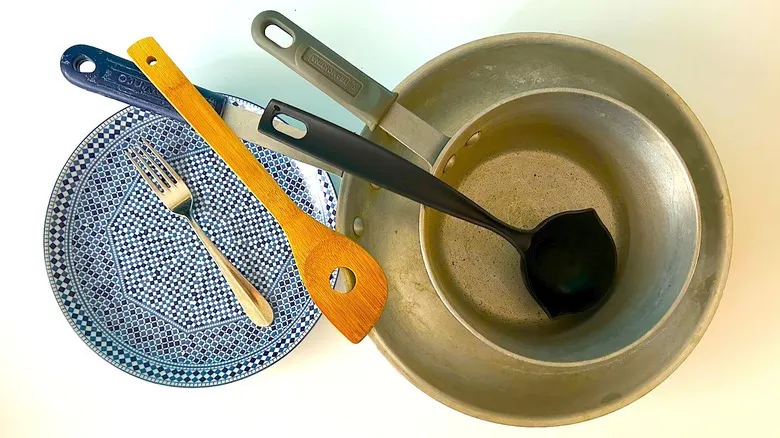
1 average saucepan
1 average frying pan
Wooden spatula
Soup ladle
Serving dish
Fork utensil
Heat the stock in a medium saucepan

To effectively release the amylopectin starches from Arborio rice, it's essential to gradually incorporate heated stock as the dish cooks. Cold stock will not extract this starch from the rice grains. Whether you opt for store-bought or homemade stock, ensure it is properly heated before adding it to your risotto, and keep it warm on a low burner throughout the cooking process. Aim for a gentle simmer rather than a vigorous boil, as you want to minimize evaporation before you can mix it with the rice.
While broth can be used, it has a notably different flavor profile compared to stock. Broth is typically made by simmering meat with aromatics in water, whereas stock is created using animal bones. The latter is generally richer due to the gelatin released from the bones during simmering, resulting in a more complex and sophisticated flavor in your risotto.
Sauté the onion and garlic
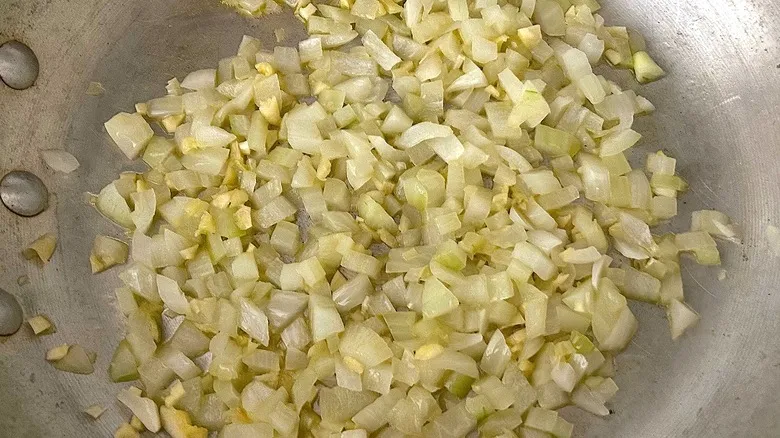
After the stock has been heated, it's time to sauté the onions and garlic using one tablespoon each of unsalted butter and extra virgin olive oil. Combining both fats helps prevent the butter from burning while still providing the rich mouthfeel that butter offers. If you prefer, you can use coconut oil, canola oil, or any fat of your choice for the risotto, but keep in mind that the final flavor and texture will vary slightly.
To sauté the onions correctly, set the burner to medium-high heat. Allow the butter to melt before adding the onions. Once the onions are in the pan, lower the heat to medium. This process should take about five to eight minutes, depending on your stove. The onions are done when they become translucent and fragrant.
After the onions are cooked, add the minced garlic to the pan. Sauté the garlic for about one minute, or until it becomes aromatic. Be careful not to overcook the garlic, as it can burn easily, resulting in a bitter taste that will affect the overall dish.
Toast the rice
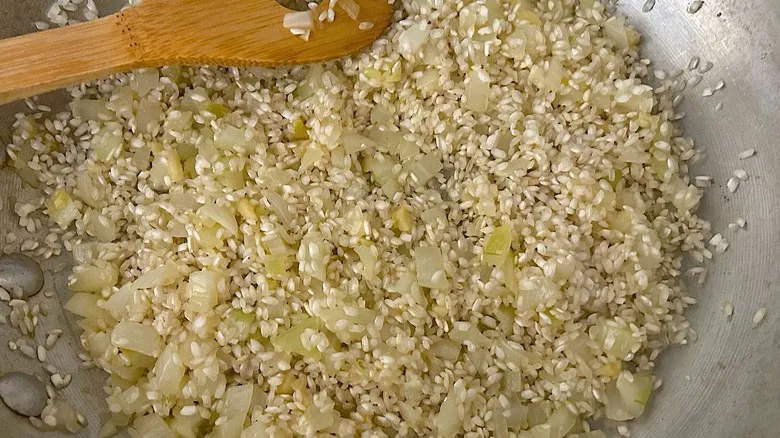
While it's typical for recipes to recommend rinsing rice before cooking to remove contaminants and excess starch, this step is not necessary for most short-grain rice varieties, such as Arborio. This is particularly relevant when preparing risotto, as the goal is to retain the starch, which will be released into the liquid, resulting in a rich and creamy texture.
The next step in making risotto involves adding the unwashed Arborio rice to the pan and toasting it to enhance its nutty flavor. This process should take about three to five minutes, or until you start to notice a toasty aroma wafting from the rice.
Add the seasonings
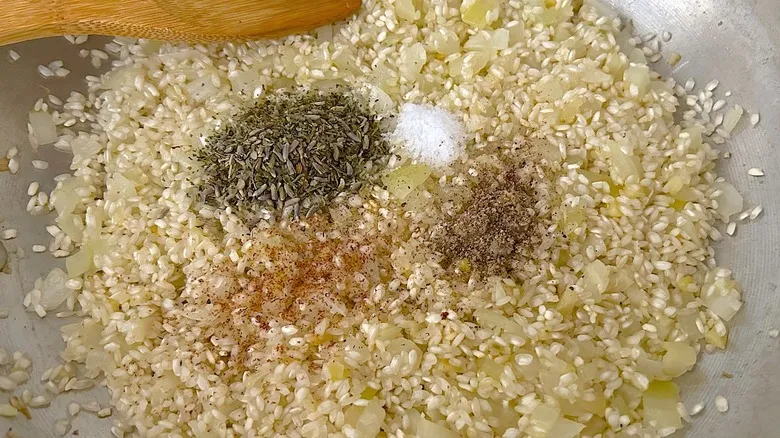
At its core, risotto needs just salt and pepper to enhance the flavor of the rice. I prefer kosher salt in my cooking because its larger flakes are easier to manage and control, plus it contains no additives. I add it early in the cooking process to ensure it seeps into the rice grains, seasoning them evenly.
While not essential, I recommend incorporating additional seasonings to elevate the flavor of your risotto. My favorite blends for this dish are dried Italian seasoning or herbes de Provence.
I also like to add a dash of freshly grated nutmeg for a touch of brightness and a subtle sweetness that can truly elevate the dish. Although pre-ground nutmeg is an option, it lacks the robust flavor of freshly grated nutmeg. Therefore, I suggest keeping whole nutmeg on hand and using a microplane for grating.
Deglaze the pan with wine
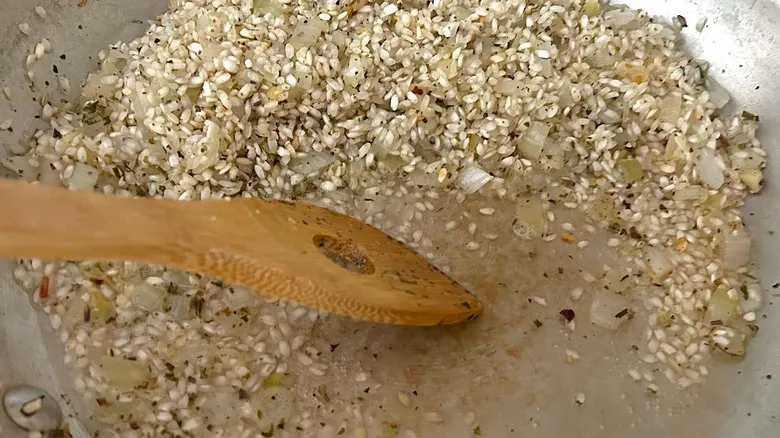
Before you embark on the lengthy process of adding stock to your rice, it's essential to deglaze the pan with wine. Deglazing involves introducing a liquid to the pan to lift the flavorful bits known as the fond. The fond consists of the browned remnants that accumulate at the bottom of the pan from sautéing onions and garlic and toasting the rice. This fond is rich in flavor, and when you scrape it off the pan, it gets reintroduced into the risotto, enhancing its taste.
While you can use water or stock for deglazing, wine provides an additional depth of flavor. The key is to choose the right type. For this purpose, opt for a dry white wine that is not oaky and has a relatively high acidity. I typically prefer a pinot grigio or a sauvignon blanc, but an unoaked, buttery chardonnay would also work well. Avoid using cooking wine for deglazing, as it often contains high levels of salt and preservatives that can negatively affect the flavor of your risotto.
Start adding stock to the rice

Once the browned bits of fond have been scraped up and the wine has been absorbed by the Arborio rice, the gradual process of incorporating the hot stock into the risotto begins. Lower the heat to medium-low and start adding the stock to the pan, one ladle at a time. Gently stir the risotto occasionally until the stock is completely absorbed by the rice.
Avoid adding more stock until the liquid has been fully absorbed; otherwise, you risk overcooking or undercooking your risotto. This requires a careful balance of timing, a bit of effort, and self-control. Risotto cannot be rushed; it takes as long as it needs.
Continue adding stock until the rice is cooked

Keep adding the stock gradually, one ladle at a time, until the rice reaches a delightful al dente texture, ensuring it doesn’t break apart. This process should take around 20-30 minutes. The final dish should appear naturally creamy, not watery.
If you find that the rice is still too firm in the center after adding four cups of stock, you may need to pour in a bit more and heat it, continuing to mix it into the risotto until the rice is perfectly al dente. This situation can arise if the rice is older or if you are at a higher altitude. Moreover, adding the stock too quickly or cooking the rice at excessively high temperatures can cause it to absorb more liquid than necessary, leading to overcooked risotto.
Stir in remaining butter and Parmesan cheese
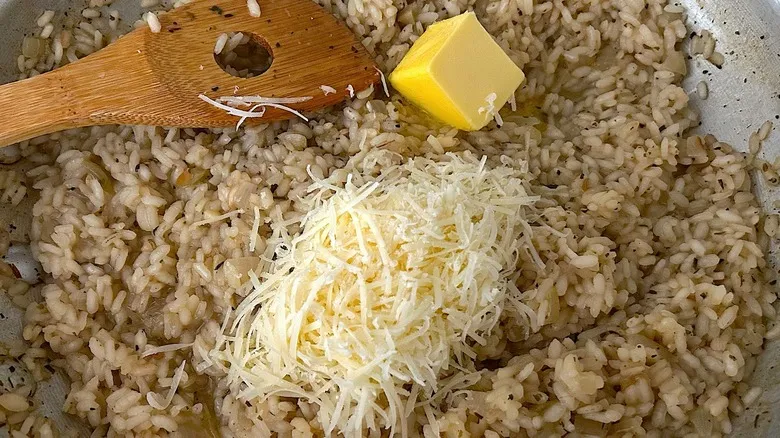
After the risotto is done cooking, complete the dish by carefully mixing in the last two tablespoons of unsalted butter and the freshly grated Parmesan cheese. Stir until both the butter and cheese have melted.
Serve hot with garnish

Risotto should be served right away, piping hot. If you're including it in a meal with other dishes, ensure everything else is prepared in advance to avoid overcooking the risotto. Add a sprinkle of freshly chopped Italian parsley for a vibrant touch and a burst of fresh, herbal flavor.
How long does risotto last and how to store it

Like many other cooked dishes, risotto doesn't taste as good when reheated as it does when freshly made. However, it can be kept in an airtight container in the refrigerator for a maximum of three to five days. To store risotto properly, it's important to cool it down quickly to stop the cooking process. You can do this by transferring it from the pan to a baking sheet, spreading it out in a single, thin layer. Always label the container with the date so you know when to discard any leftovers.
If you can't consume the risotto within the three to five-day timeframe, you can freeze it, although this is not ideal. The freezing process can negatively affect the starches in the rice, resulting in a gritty texture when thawed and reheated. If you choose to freeze risotto, place it in freezer bags and label them with the date. Avoid keeping frozen risotto for more than a month. When you're ready to use it, thaw the risotto in the refrigerator overnight before reheating. A great way to utilize frozen risotto is to make arancini, which are fried risotto balls, where the texture of the frozen rice is less noticeable.
How to reheat risotto
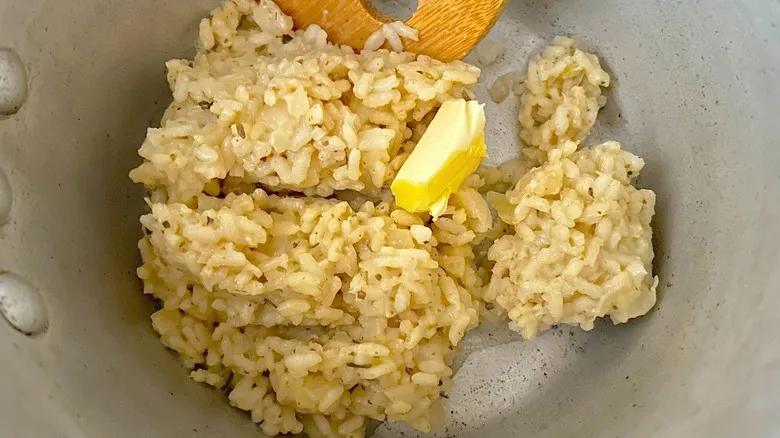
While it's possible to reheat risotto in the microwave, doing so can compromise its texture, making it sticky instead of creamy. A far superior method is to place the cold risotto in a saucepan, adding a few tablespoons of chicken stock or water along with a small piece of butter.
Gently warm the risotto over low heat, stirring occasionally, until the butter has melted and the dish regains its original creamy consistency. You may need to tweak the seasoning slightly to account for the extra liquid, but this approach will yield a result that is much closer to freshly made risotto than any other reheating method.
Additional risotto recipes, subs, and swaps

There are countless variations of a risotto recipe, just as there are chefs with unique styles. Some of my favorites include a risotto brimming with different types of mushrooms and a rich seafood version that features calamari, mussels, scallops, and shrimp. If you find yourself with leftover canned pumpkin after making a pie, consider trying this autumn-inspired risotto, packed with umami-rich bacon, parmesan cheese, and toasted hazelnuts.
I also suggest taking inspiration from risotto by experimenting with various liquids beyond plain water for cooking rice dishes of any kind. Water can be quite dull, regardless of how upscale the label on that fancy spring water bottle may appear. Stock, broth, wine, coconut water, tomato water, dashi, tea, and even beet juice are all excellent options to elevate this simple grain.
Finally, if you believe Arborio rice is only suitable for risotto, think again. This rice variety shines in a variety of dishes, from paella to soup to a creative take on jambalaya. However, one of the best uses for this short-grain rice is in a sweet or savory rice pudding, such as this comforting ginger chicken jook. The starchiness of Arborio rice lends a particularly creamy texture to the dish, enveloping the chicken and infusing it with the warmth of chili oil.
Recommended

How To Use A Crock-Pot Like A Pro

The Basic Pantry Staple That Removes Stuck-On Food From Cast Iron Pans

The Worst Caviar Mistake You Can Make Starts With The Spoon

The 3 Kitchen Tools You Need For Restaurant-Worthy Mashed Potatoes
Next up

